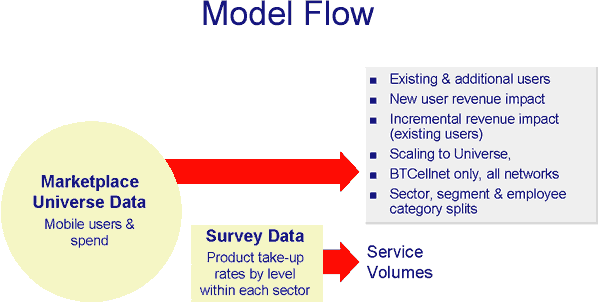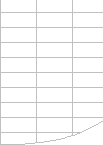
Customer-Driven Segmentation:
BTCellnet's Ambitious Approach To Sales And Business Planning
For Mobile Phone Services And Products
BTCellnet commissioned RS Consulting, A UK-based
research consultancy specialising in IT and telecommunications,
to build a comprehensive model of the potential market for a wide
range of value added service products among the company's corporate
Accounts. This ambitious project was designed to provide BTCellnet
with a cutting edge, user friendly information platform and analysis
tool for sales and business planning into the new Millennium.
The model was built by Decision Models
using Microsoft Excel.
Integrating Customer-Driven Segmentation with Portfolio-Based
Service Planning and Demand Forecasting
BTCellnet set four key objectives for the project:
1. To develop a new and original customer-driven segmentation
for mobile communications services based on attitudes:
2. To quantify the opportunity represented by each segment
within the total universe of BT Corporate Accounts (projected
to end 2001) and to enable each segment market to be mapped
to demographic descriptors used within the BT sales channel
3. To quantify potential take-up of specific types and performance/functionality
levels of value added service (targeted both at individual mobile
phone users and at corporate entities) within a model framework
which enabled potential to be analysed by different combinations
of segment and demographic descriptor
4. To provide practical tools for helping Account representatives
to determine the most appropriate segment classification for
specific Accounts and for selecting specific product packages
or menus from the overall portfolio of services most relevant/attractive
to that segment.
Building the model
The modelling process had two key objectives:
1. To integrate secondary market universe data with original
survey data :
-
Quantify revenue impact and projected
take-up volumes by service/service level option to end 2001
-
Quantify the potential for each product
by attitude segment, employee category, demographic sector
and BT sales channel
2. Provide a powerful, yet easy to use tool for end
users to analyse, explore and explain survey data and to test
different scenarios for product demand.

Built in Microsoft Excel, the model uses the powerful
pivot table function to enable managers to drill down into
the data by a simple 'drag and drop' process and allows users
also to change key ratios and assumptions through both pre-defined
drop down menus and manual entry.
Updating and Developing the Model
The model has been devised so that it can be updated
in several dimensions:
-
By refining the universe data
-
By conducting new basic fieldwork
on numbers and types of mobile user/mobile spend
-
By conducting new fieldwork on service
product interest/preference
-
By extending the model to a new Universe
eg SMEs
-
By altering some of the core assumptions
eg on incremental revenue impacts
-
By building in more sophisticated
price/take-up assumptions for individual products based
on specific research
A Tool For Improving Sales Effectiveness and Profitability
The segmentation model provides a uniquely flexible tool
for improving sales effectiveness and profitability by providing:
- A detailed and reliable platform of data on mobile usage
and mobile spend within the corporate account universe for
developing business forecasting scenarios on phone penetration
and applications drivers
- A tool for projecting potential take up of different potential
value-added service products' and the levels of functionality
required for each product, by sales channel/market segment
(and for testing the impact of alternative scenarios)
- A basis for devising product packages/bundles and or customisable
menus and for targeting these at specific segments within
the universe
- A basis for devising effective messaging about the benefits
and values of mobile communications (to reinforce or change
existing attitudes/prejudices)
|








